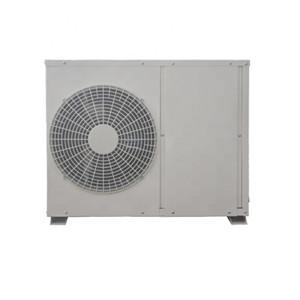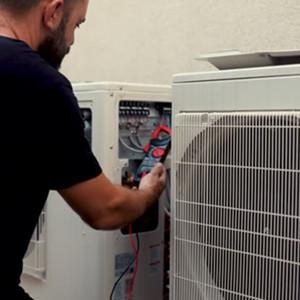Heat Pump Coils Frozen
Whether you like it or not, your heat pump will sometimes run into common problems. Depending on the problem, they may be easy to fix or they may be a precursor to a larger problem. Being able to identify these issues is critical.
One of the problems is having to deal with a frozen evaporator coil. This happens when condensation builds up on the evaporator coil and doesn't dissipate in time. The most likely cause is a dirty coil or air filter, but it can also be caused by a lack of airflow in the system.
Why do evaporator coils freeze?
In a heat pump system, the evaporator coil is responsible for absorbing heat from the air flowing through your home. It is then transferred through the refrigerant, which heats or cools the air and then blows it out.
As a result of this process, condensation will form on the coil. Most of the time, this condensation works well. When something goes wrong with the cooling process, the condensation will eventually freeze. When the evaporator coil freezes, it cannot properly distribute air throughout your home.
What causes evaporator coils to freeze?
There are four main reasons for a frozen evaporator coil: improper air flow, a dirty air filter, low refrigerant, or a dirty evaporator coil. Being able to recognize different characteristics can help you identify and solve problems quickly.
1. Insufficient airflow.
Your heat pump system requires proper airflow for all components to work properly. When not enough hot air comes in, the evaporator coil can freeze. It could be anything from a faulty air handler to something as simple as an enclosed air conditioner. Without proper airflow, the coil won't get the heat it needs to thaw.
2. Low refrigerant content.
When a leak occurs, refrigerant can escape the system. When a system doesn't have enough refrigerant, it won't function properly. Sometimes, it's as simple as refilling the refrigerant. Others mean a leak needs to be fixed.
3. The air filter is dirty.
You'd be surprised how many times a dirty air filter is the cause of the problem. A dirty filter can restrict airflow within the heat pump system, causing the same problems as above. Additionally, a dirty or clogged filter means dust and debris can accumulate on the evaporator coil, compounding the problem.
4. Dirty evaporator coil.
If all other checks are OK, the evaporator coil may be dirty or clogged. This way, the coil has a harder time absorbing the heat it absorbs from the air in your home. Without heat, the coil won't thaw and will freeze before you know it.

What if the evaporator coil freezes?
The good news is that in most cases, you can troubleshoot a frozen evaporator coil yourself. It takes a little time to locate the problem, but when you determine where the problem is, the fix is usually easy.
1. Check airflow.
First make sure all registers are open. If this doesn't fix the problem, check to make sure all pipes are clean and free of debris. If things are good, you can move on to other issues.
2. Clean/replace air filter.
Since air filters are a common problem, the quickest solution may be to clean or replace the air filter. Depending on the age and condition of the filter, it may be quicker and easier to replace it entirely. Consider replacing it every two months to ensure it continues to work at its best.
3. Clean evaporator coil.
If you're sure the airflow is good and the filter isn't the problem, check the coil itself. It may be clogged and dirty, or it may be cracked and not working. If the coil is in good condition, use a rag and soft-bristled brush to clean it. If it's damaged, you can replace it, but it's best to leave it to a professional.
How long does it take to thaw an evaporator coil?
When the refrigerant in the heat pump gets too cold, it can cause the evaporator coil to freeze. While this is not abnormal, it can be helpful to know the waiting period during the thawing process.
Generally speaking, you need to wait about 3 or 4 hours for the coil to thaw. Make sure it's clean and free of clutter and has good airflow. Otherwise, you may have to completely replace the evaporator coil to get it working properly again.
Preventive maintenance is important
One of the most important aspects of an HVAC system or heat pump is maintenance. Preventative maintenance is in place to ensure that all individual components are functioning properly and that there are no potential issues.
More importantly, it will help prevent major problems from occurring. When you have a professional inspect your heat pump system regularly, no issues will go unchecked for long.
Regular cleaning is also a good idea. Over time, dust, dirt, and debris can clog the system, limiting its effectiveness and causing problems.
What are the signs that your evaporator coil is frozen?
Maybe you’re not the savviest DIY HVAC technician. Knowing what to look for in a heat pump can help you identify specific problems and at least be able to forward that information to a technician if they have a problem.
There are 4 signs that your heat pump evaporator coil is frozen. Know the warning signs. You can then fix these issues, or at least point them out to help the technician make repairs in a short time.
1. Find ice.
This one is very simple. If you notice ice on your outdoor refrigerant line, it's a safe bet that it's frozen. You can work to eliminate some of these problems, but it may reappear before long, so troubleshoot to find the source of the problem.
2. Check for moisture and condensation.
Look around the air handler. If you notice any moisture or condensation building up, this could be a sign that the evaporator coil will freeze sooner or later. This is one of the signs that you can nip the problem in the bud before a freeze occurs.
3. Drainage pan.
Is the condensate drain pan full or even overflowing? Check the pot itself. If there are no obvious cracks, you may have a clogged drain or another problem that is causing the drain to overflow before the condensation evaporates.
4. Check the coil.
If you sense a problem with the evaporator coil, turn on the air handler and inspect the coil itself. Look for condensation or ice, then inspect the source of the problem.
How do I know if my heat pump is low on refrigerant?
As mentioned before, a lack of refrigerant may be the problem. The question is, how do you know when there is a problem with your refrigerant? Thankfully, there are 3 signs that refrigerant may be the culprit of your heat pump problems.
1. Leakage.
If you notice a heat pump leak, this is the first sign of a refrigerant leak. The function of this system is to change the refrigerant from gas to liquid and vice versa. Refrigerant should not degrade over time. However, when a leak occurs, it can mean a loss of refrigerant from the system. You may notice pools of water sometimes forming around your heat pump outdoor unit.
2. Shaved ice.
When a heat pump leaks, ice can form on the evaporator coil. While condensation is the typical cause of freezing, it's usually because refrigerant is leaking elsewhere in the system. The problem with icing is that just scratching isn't enough. It requires an HVAC technician to come out and add more refrigerant while also sealing the leak.
3. Lack of performance.
It may not necessarily be that obvious when the refrigerant is low. If you find that your heat pump isn't functioning fully as it should, it could be a sign of a larger problem. Low refrigerant levels can put stress on other components within the heat pump. Excessive stress can cause damage especially to compressors. Increased electricity costs can be a red flag that you are running low on refrigerant.
Don't be afraid to call a professional
While it's understandable to want to save money with a DIY fix, it's not always the best idea. Especially when refrigerants are involved, sometimes it's best and required by law to call a technician. Don't be afraid to make this call.
Keep following us
Leomon is a professional heat pump manufacturer. We'll be posting some free heat pump maintenance tips. Please continue to follow us to make better use of your heat pump.





